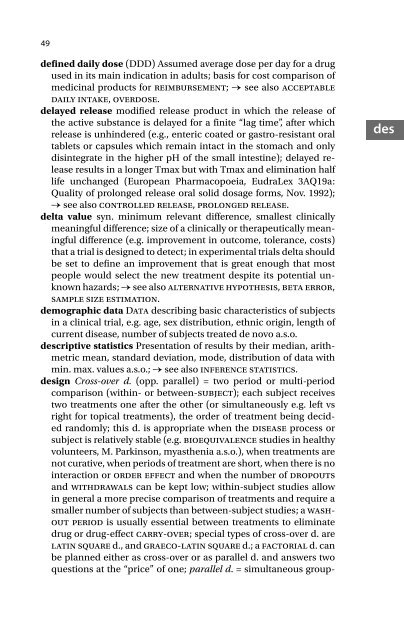220-Dictionary of Pharmaceutical Medicine, 2nd Edition-Gerhard Nahler Annette Mollet-3211898352-S
220-Dictionary of Pharmaceutical Medicine, 2nd Edition-Gerhard Nahler Annette Mollet-3211898352-S
220-Dictionary of Pharmaceutical Medicine, 2nd Edition-Gerhard Nahler Annette Mollet-3211898352-S
Create successful ePaper yourself
Turn your PDF publications into a flip-book with our unique Google optimized e-Paper software.
49defined daily dose (DDD) Assumed average dose per day for a drugused in its main indication in adults; basis for cost comparison <strong>of</strong>medicinal products for reimbursement; → see also acceptabledaily intake, overdose.delayed release modified release product in which the release <strong>of</strong>the active substance is delayed for a finite “lag time”, after whichrelease is unhindered (e.g., enteric coated or gastro-resistant oraltablets or capsules which remain intact in the stomach and onlydisintegrate in the higher pH <strong>of</strong> the small intestine); delayed releaseresults in a longer Tmax but with Tmax and elimination halflife unchanged (European Pharmacopoeia, EudraLex 3AQ19a:Quality <strong>of</strong> prolonged release oral solid dosage forms, Nov. 1992);→ see also controlled release, prolonged release.delta value syn. minimum relevant difference, smallest clinicallymeaningful difference; size <strong>of</strong> a clinically or therapeutically meaningfuldifference (e.g. improvement in outcome, tolerance, costs)that a trial is designed to detect; in experimental trials delta shouldbe set to define an improvement that is great enough that mostpeople would select the new treatment despite its potential unknownhazards; → see also alternative hypothesis, beta error,sample size estimation.demographic data Data describing basic characteristics <strong>of</strong> subjectsin a clinical trial, e.g. age, sex distribution, ethnic origin, length <strong>of</strong>current disease, number <strong>of</strong> subjects treated de novo a.s.o.descriptive statistics Presentation <strong>of</strong> results by their median, arithmetricmean, standard deviation, mode, distribution <strong>of</strong> data withmin. max. values a.s.o.; → see also inference statistics.design Cross-over d. (opp. parallel) = two period or multi-periodcomparison (within- or between-subject); each subject receivestwo treatments one after the other (or simultaneously e.g. left vsright for topical treatments), the order <strong>of</strong> treatment being decidedrandomly; this d. is appropriate when the disease process orsubject is relatively stable (e.g. bioequivalence studies in healthyvolunteers, M. Parkinson, myasthenia a.s.o.), when treatments arenot curative, when periods <strong>of</strong> treatment are short, when there is nointeraction or order effect and when the number <strong>of</strong> dropoutsand withdrawals can be kept low; within-subject studies allowin general a more precise comparison <strong>of</strong> treatments and require asmaller number <strong>of</strong> subjects than between-subject studies; a washoutperiod is usually essential between treatments to eliminatedrug or drug-effect carry-over; special types <strong>of</strong> cross-over d. arelatin square d., and graeco-latin square d.; a factorial d. canbe planned either as cross-over or as parallel d. and answers twoquestions at the “price” <strong>of</strong> one; parallel d. = simultaneous group-des


